Agribusinesses make hundreds of decisions every season: when, where, and how much to water, fertilize, spray with pesticides, and so on and so forth. Each choice affects yields, input costs, and long-term soil health. Without clear data, many of these decisions rely on habit, guesswork, or outdated patterns. That’s a risk modern farming can’t afford.
A smart crop health monitoring system for agribusiness replaces hunches with field-level facts. It shows where crops are stressed before symptoms spread, tracks how interventions work throughout the season and later on, and helps avoid overuse of inputs. That’s how sustainability looks in practice.
The Three Pillars Of Sustainable Agriculture
Modern agriculture faces a growing squeeze. Food demand keeps rising, but water and land are limited. Meanwhile, more frequent extreme weather events (e.g., droughts, floods, and hail) complicate planning. Conventional farming used to rely on heavy water use and agrichemicals, which can dran resources and reduce profits. Sustainable agriculture addresses these issues by focusing on the three core elements:
- Environmental. Careful use of land, water, and natural habitats to keep ecosystems alive.
- Economic. Long-term farm income through stable yields, lower input costs, and risk reduction.
- Social. Supporting rural life with jobs, fair treatment, and local food security.
These pillars work together. If one is weak, the whole system suffers. That’s why agribusinesses need new tools and methods to manage complexity and make choices that support both the land and their livelihoods.
Why Growing Enough Food Is Getting Harder
Walk through any supermarket, and it’s easy to believe the world has food to spare. Yet behind this abundance is a fragile system under pressure. Food production must rise by about 70% by 2050, but the land and water to support it are already stretched thin. Over 3 billion people live in regions with high water risk. And while yields have improved fourfold since the 1960s, the cost has been steep: degraded ecosystems, rising input use, and over $10 trillion a year in hidden damage.
Expanding farmland isn’t an option. Efficiency is the only path forward. With less room for error, agribusiness depends on smarter, faster decisions. That’s where agricultural monitoring software moves from luxury to necessity.
What Is Agricultural Software And How Does It Work?
Agricultural software is a digital system to aid farmers in managing their fields, inputs, and operations more effectively. It combines tools for planning, tracking, and decision-making in one platform, allowing farmers to monitor all aspects of their business, from land use to finances, in near real-time.
How it works is simple in principle but powerful in effect. First, the software collects data from different sources: GPS-guided agricultural machinery, soil sensors, UAVs, satellite images, and manual entries by workers. This data shows what’s happening on the ground, including soil moisture, crop health, weather conditions, and more.
Next, the crop monitoring software analyzes this information using built-in models (sometimes AI-powered). It highlights issues like low soil nutrients, pest threats, or signs of overwatering. Based on this, it suggests actions: whether to start or delay planting, when to irrigate, and what nutrients to apply.
Many agriculture monitoring systems go further, offering automation features. For example, farm managers can schedule irrigation or spraying from a smartphone or import VRA maps into a tractor to apply pesticides only to affected areas.
Key areas covered by agricultural software include:
- Field activity tracking. Keeps a daily log of work done, throughout the whole growing season. This helps identify slowdowns or inefficiencies.
- Crop and livestock planning. Provides calendars for crop rotation, pest control, and livestock care routines.
- Financial tracking. Records costs and sales to help agribusinesses forecast profit and spot unnecessary spending.
- Risk alerts. Warns of problems like drought, pests, or disease based on recent field data and past trends.
All data is stored in the cloud, so it’s accessible from any device. This means managers can track performance even if they’re not on-site.
So, farm monitoring software helps reduce losses, improve efficiency, and prepare for the season ahead. It supports both small farms and large enterprises in making more sustainable everyday decisions.
Using Crop Monitoring Software For Everyday Sustainable Practices
One of the hardest parts of sustainable farming is knowing whether long-term practices are actually paying off. Healthier soil, lower inputs, and more stable yields are the results that take time and, without data, are hard to prove.
Farm tracking software connects the dots. On top of recording each season’s details, it patterns across years and decades. Now, sustainability-focused farmers know how cover cropping affected weed pressure, how water use dropped with new irrigation timing, or how yields held steady even with less fertilizer.
Software-enabled feedback loop demonstrates that sustainability is attainable and, more importantly, advantageous to farmers. Some farms report $8 to $12 returned for every $1 spent on software when it’s used to adjust inputs and plan smarter. The return comes from hundreds of small, well-timed decisions made throughout the growing season, year after year.
Crop monitoring software also lightens the mental load. Instead of holding dozens of variables in their heads, farmers get a structured, long-term view of their land’s needs across seasons. This clarity is hard to put a price on.
Ask any farmer: doing things the right way often takes more work upfront. Farm monitoring systems help realize whether that effort is actually paying off. When you can see the numbers shift — fewer inputs, steadier yields, less waste — it becomes easier to keep going. That’s how sustainability becomes part of the everyday routine.
______________
Author: Vasyl Cherlinka
Vasyl Cherlinka is a Doctor of Biosciences specializing in pedology (soil science), with 30 years of experience in the field. With a degree in agrochemistry, agronomy and soil science, Dr. Cherlinka has been advising on these issues in the private sector for many years.












